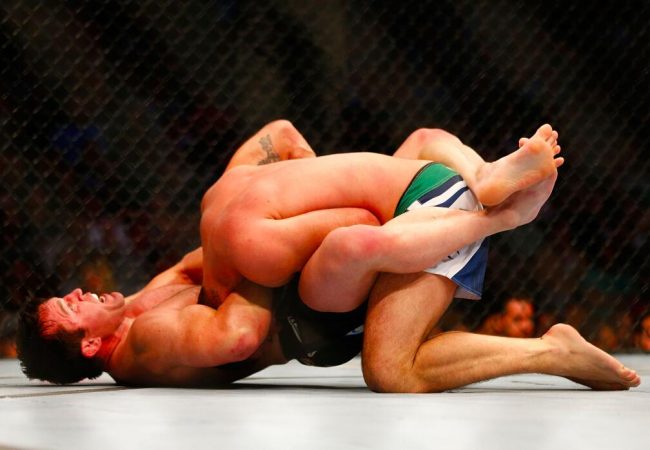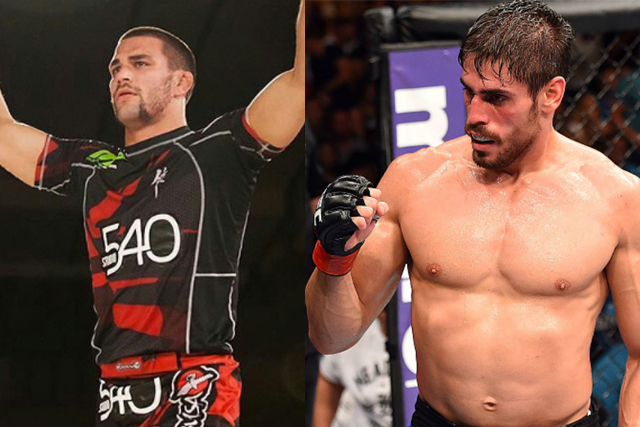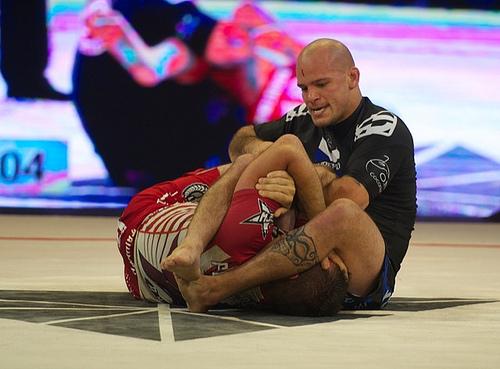
Blue belts, Jiu-Jitsu's future / Photo: Regis Chen/GRACIEMAG
At the 2012 Jiu-Jitsu World Championship, which ends this Sunday in Long Beach, California, some blue belts hit their marks, with patience and plenty of determination, of making it to the divisional top spot.
In the male and female blue belt absolutes, Pedro Lucas Araújo of Gracie Barra and Monique Elias of Alliance, respectively, came out the grand champions. They are the two best blue belts in the world today.
They’re a bit above some other aces, like silver medalist Ali Seena Munfaradi of Alliance and bronze medalists Paulo Henrique Silva of Nova União and Jared Lynn Dopp of Ribeiro JJ in the men’s division; and silver medalist Julia Forrester of Alliance and bronzes Erica Plummer of Lotus Club and Ana Carolina Vieira, Rodolfo Vieira’s sister, of GF Team.
In their honor, and yours if you’re a blue belt, your favorite Jiu-Jitsu-lesson website dug through the treasure chest and came up with an article from August 2009 – a dossier on all you need to know to make it from blue belt to purple.
The article brings a series of illustrated positions and tricks. Here, we abridged the text to feature only what is most useful, adding some videos to help out.
Milton Regis — Leader of Kioto BJJ Sayville, NY
“Confidence is something to work on and needs to be exercised, like a new move, by both students and teachers. I say teachers, as it’s their job to identify who among their students are at the point of giving up. How does one help them? By offering special attention, correcting details, motivating them every time they get something right and every time they notice a little progress, suggesting private lessons and not forcing them to participate in competitions if that’s not the student’s objective. Beyond that, if missing fundamentals are not corrected at blue belt, it’ll be hard to fix down the road.
Ricardo “Cachorrão” Almeida — leader of RABJJ in New Jersey
“If I were to point out the three most common mistakes blue belts make, the first would certainly be posture. They’re often caught in triangles or swept for having the wrong posture. To correct that, my students learn to open the guard standing and pass the guard folding their opponent over. The second mistake is in taking the back. I see blue belts lose the position for trying to put in two hooks at once. To correct that they should pull the adversary to them and put in one hook at a time. And the third mistake is using force during combat. Out of inexperience, they tend to use force rather than technique, which can cause injury. To correct that, in the young ones, time and experience fix the problem most of the time. Now with older practitioners, I make it really clear that only by getting squashed up in training will they correct their mistakes.”
Paulo Tavares — leader of Paulo Tavares Academy in Australia
“When on bottom and mounted, a good player never extends an arm or gives up his back to escape. Keep the head on the ground and elbows up against the body. That Helio Gracie used to say. I also like working on the players’ emotional side. Here in my gym, we like to say everyone’s a champion. Last year, I took my students to compete and as we’ve only been working together for a year, I’d have been happy if they just kept from getting submitted, but to my surprise, the eight who competed came out champions.
http://www.youtube.com/watch?v=7cDaa2i04CU
Sérgio Correa — leader of team Marra Senki in the USA
“When addressing the mistakes of blue belts, the first thing I think of is controlling the position, then positional variations, like for example variations on chokes and armbars; and lastly insistence on the mistake, which only ends with lots of specific training.
João Pedro Santos — leader of Choke Academy in Scandinavia
“I’ll start with the cross-over collar choke. Blue belts are premature in squeezing before sinking the hold, or squeeze bringing their elbows outwards. To correct that, the wrists need to be in contact with the neck when adjusting and the elbows near each other while pressure is focused on the wrists. In the guard, another mistake is posture. Blue belts lean forward or to one side or another, making it easier for the one on bottom to attack. And when on bottom, they don’t busy themselves with breaking the adversary’s posture before launching an attack, making it easier to pass their guards. On bottom, they should have it clear in their heads that they must break the posture of the one on top. Lastly, I see lots of blue belts buying DVDs and books by big Jiu-Jitsu stars, but for lack of experience they’re unable to discern what is really important. In this case, the best thing to do is learn the fundamentals before going on to specialize.”
Vinícius “Draculino” Magalhães — leader of GB Texas
“Blue belt is the toughest moment in the journey through Jiu-Jitsu. In this case, there’s a great technical discrepancy between athletes, as we see in those who just got their belts and those who have become hardened training with the higher ranked. Technically, though, I point to a weakness in defending against submissions, a lack of positional adjustment and being slow to catch on to opponents’ mistakes.
Demetrius Ramos — leader of Tucson BJJ in Arizona, USA
“Blue belts don’t have great base and are taken down with ease. To improve, they need to train more stand-up techniques, as well as other options like pulling guard. Another problem is their lack of knowledge regarding the rules of the game and scoring points. For that, all they need to do is study the IBJJF’s rules and participate in refereeing courses. Lastly, blues tire too easily, mainly at big events. To improve, they need to use training sessions to get used to training even while tired.
http://www.youtube.com/watch?v=1lARD3JN1dE
Rafael Lovato Jr — leader of Lovato Jiu-Jitsu in Oklahoma, USA
“It’s hard to be specific, since blue belts still have much to learn, but there are three points that need highlighting. One should keep his arms closed when the adversary is passing his guard. Many forget to do this and let their opponent put in a hook from below, making passing the guard pretty much a sure thing. To prevent that, the arms should be stuck together and you should move on the ground till replacing guard. Another mistake is to have bad posture when trying to open the closed guard. If you are to far forward, you expose your arms to an attack. Your back should be erect. And, third, when passing guard, remember to keep your elbows tucked against your body, preventing the spider guard, sweeps, arm attacks, triangles, etc…”
Alexandre “Soca” Carneiro — leader of Soca JJ in New York, USA
“In the half-guard, on bottom, often fighters clutch the opponent’s back with the left hand, which is wrong. That way the one on bottom brings more pressure down on himself. The right thing to do is go in with the arm under the opponent’s armpit to open up room to replace guard. When caught in a foot lock, don’t roll away from the side being pulled, but to the side the pressure’s coming from. When attacked with a choke, don’t try opening your own gi, which will help your opponent sink the hand in. A good option is to protect the neck with your hands behind your head.”
What about you, what do you feel the most common mistake blue belts make in Jiu-Jitsu is? Comment below.




